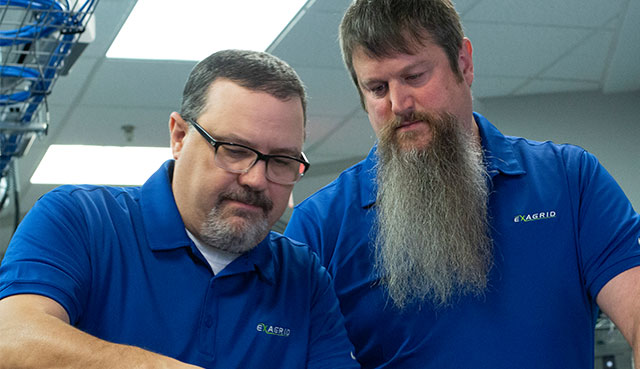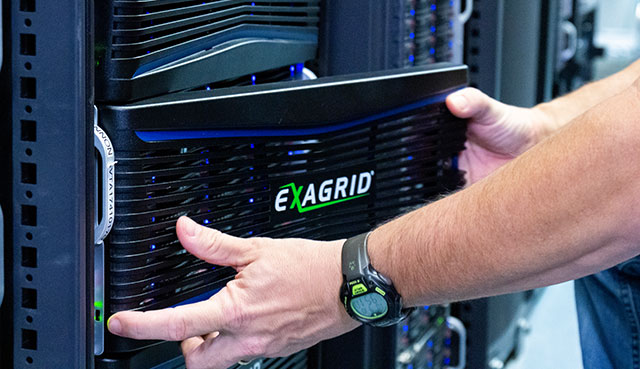The long-term retention data is then tiered into a long-term retention deduplicated data repository for cost efficiency. The benefit of this combined approach provides:
- 3x the ingest rate resulting in the shortest backup windows,
- Additional backup performance with with OST integration,
- 20x faster recoveries with the ExaGrid Landing Zone,
- Automated and accelerated disaster recovery and unbalanced onsite and offsite retention through OST,
- Great deduplication ratio resulting in 1/2 to 1/3 the storage required for lower cost.
- Through integrating with NetBackup disk pooling, ExaGrid enables a scale-out storage architecture to a single policy target.
Joint ExaGrid/NetBackup customers are able to monitor the status of their onsite and offsite backups and facilitate disaster recovery through the NetBackup console.
Using NetBackup Accelerator? See here.
Why Does NetBackup Need ExaGrid Tiered Backup Storage?
The combination of NetBackup and ExaGrid’s appliances in a scale-out system creates a tightly integrated end-to-end backup solution that allows backup administrators to leverage the advantages of a scale-out approach in both the backup application as well as the backup storage.
There are 2 traditional approaches for deduplication for NetBackup. The first is performing the deduplication in the NBU media server bundled as an NBU 5200/5300 appliance. The second is performing the deduplication in a inline deduplication dedicated appliance where data is deduplicated before the data is written to disk. Both of these have inherent challenges (similar to those of Dell EMC Data Domain).
- Inline deduplication, whether in the NBU appliance media server software or in the inline appliance uses a lot of compute resources which slows the backups down.
- All the data is written to disk in a deduplicated format and needs to rehydrate for every restore, VM, tape copy, etc. resulting in slow restores times.
- As data grows, the server or controller architecture does not and as a result the backup window get longer and longer.
- The hardware architectural approach leads to fork-lift upgrades and product obsolescence.
(See NetBackup Accelerator page for details on our integration with incremental forever backup.)
The Drawbacks Of Inline Deduplication On Backup Performance:
Deduplication is compute intensive and inherently slows backups, resulting in a longer backup window. Some vendors put software on the backup servers (such as DD Boost) in order to use additional compute to help keep up, but this steals compute from the backup environment. If you calculate the published ingest performance and rate that against the specified full backup size, the products with inline deduplication cannot keep up with themselves. All of the deduplication in the backup applications are inline, and all the large brand deduplication appliances also use the inline approach. All of these products slow down backups, resulting in a longer backup window.
Restore Performance On Deduplicated Data Is A Common Challenge. Why?
If deduplication occurs inline, then all of the data on the disk is deduplicated and needs to be put back together, or “rehydrated,” for every request. This means that local restores, instant VM recoveries, audit copies, tape copies and all other requests will take hours to days. Most environments need VM boot times of single-digit minutes; however, with a pool of deduplicated data, a VM boot can take hours due to the time it takes to rehydrate the data. All of the deduplication in the backup applications as well as the large-brand deduplication appliances store only deduplicated data. All of these products are very slow for restores, offsite tape copies, and VM boots.
How Does ExaGrid Address Backup And Restore Performance On NetBackup?
When you choose ExaGrid’s Tiered Backup Storage for Backup for NetBackup, each ExaGrid appliance includes a disk cache Landing Zone. Backup data is written directly to the Landing zone versus being deduplicated on the way to the disk. This avoids inserting the compute intensive process in the backup – eliminating costly slow down. As a result, ExaGrid achieves backup performance of 488TB per hour for a 2.7PB full backup. This is 3 times faster than any traditional inline data deduplication solution including deduplication performed in backup applications or target-side deduplication appliances.
Because ExaGrid’s appliance allows each full backup to first land on the Landing Zone before deduplication, the system maintains the most recent backup in its full, undeduplicated form for fast restores, instant VM recoveries in seconds to minutes, and fast offsite tape copies. Over 90% of restores and 100% of instant VM recoveries and tape copies are taken from the most recent backup. This approach avoids the overhead incurred from “rehydrating” data during critical restores. As a result, restore, recovery, and copy times from an ExaGrid system are an order of magnitude faster than solutions that only store deduplicated data.
For NetBackup Accelerator, data is written directly to the ExaGrid Landing Zone. ExaGrid then reconstitutes a full backup into the Landing Zone so that restores are the fastest possible. All long-term retention data is deduplicated in a repository for low-cost efficient storage.
In most cases, ExaGrid is at least 20 times faster than any other solution, including deduplication performed in backup applications or target-side deduplication appliances.
What about Data Growth? Will ExaGrid Customers Need a Forklift Upgrade?
No forklift upgrades or abandoned storage with ExaGrid. ExaGrid’s Tiered Backup Storage appliances are simply added to a scale-out system for easy backup storage growth as data grows. Since each appliance includes all compute, networking and storage resources are extended with each new addition – as data grows, the backup window stays fixed length.
Traditional deduplication storage appliances utilize a “scale-up” storage approach with a fixed resource media server or front-end controller and disk shelves. As data grows, they only add storage capacity. Because the compute, processor, and memory are all fixed, as data grows, so does the time it takes to deduplicate the growing data until the backup window is so long that the front-end controller has to be upgraded (called a “forklift” upgrade) to a larger/faster controller which is disruptive and costly. If new servers or controllers are released it forces users to replace what they have. Typically, vendors discontinue what you have and increase the maintenance and support. With ExaGrid, there is no product obsolescence.
ExaGrid provides appliances in a scale-out system. Each appliance has Landing Zone storage, long-term retention deduplicated data repository storage, processor, memory, and network ports. As data volumes double, triple or more, ExaGrid appliances provide all required resources to maintain a fixed-length backup window. If the backups are six hours at 100TB, they are six hours at 300TB, 500TB, 800TB, up to multiple petabytes – with global deduplication.
With ExaGrid, expensive forklift upgrades are avoided, and the aggravation of chasing a growing backup window is eliminated.
Data Sheets:
ExaGrid and Veritas NetBackup
ExaGrid and Veritas NetBackup Accelerator
ExaGrid and Veritas NetBackup Auto Image Replication (AIR)



